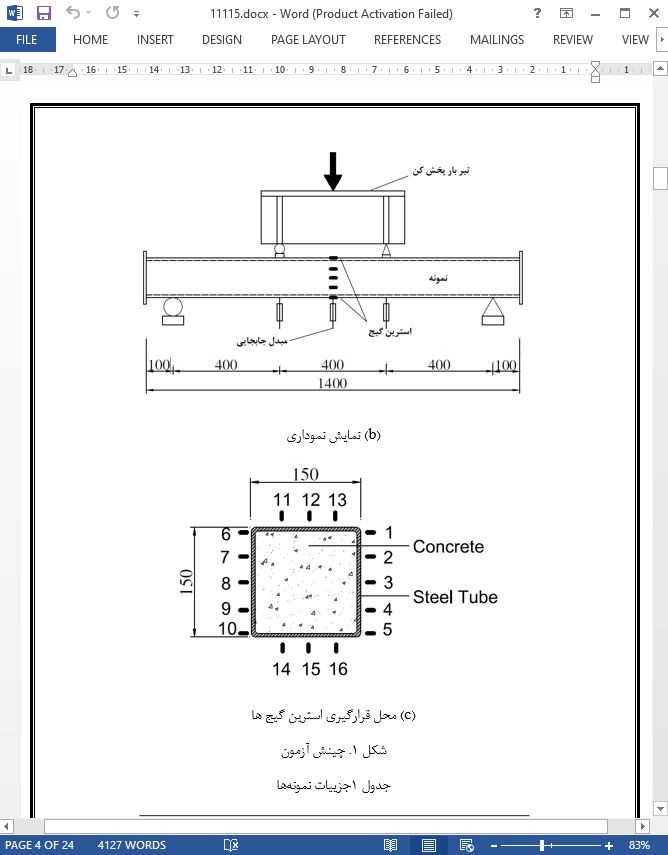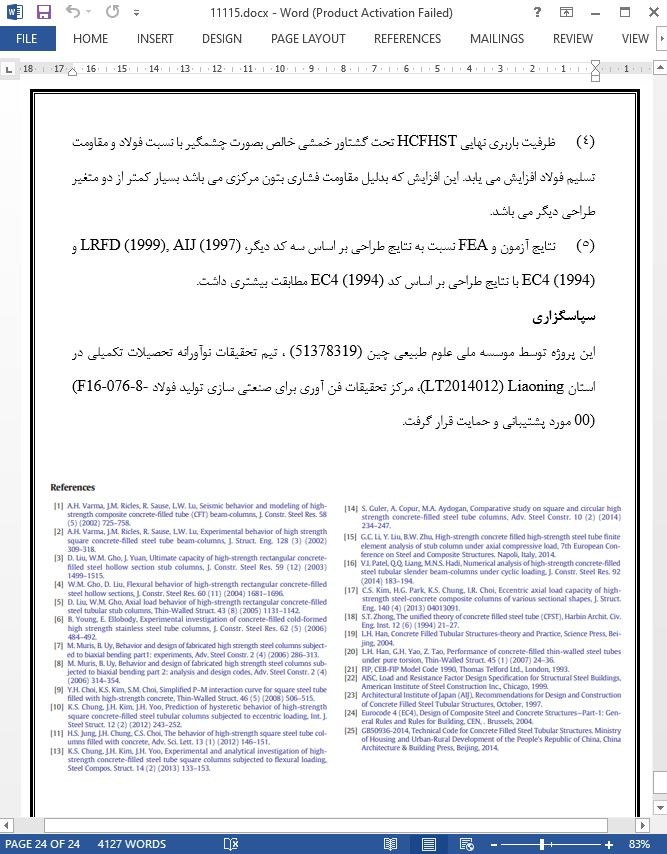
رفتار خمشی لوله های فولادی (پروفیل) مربعی با استحکام بالا و پرشده با بتون بسیار مقاوم
چکیده
برای بررسی رفتار مکانیکی لوله های فولادی (پروفیل) مربعی با استحکام بالا و پرشده با بتون بسیار مقاوم (HCFHST) تحت بار خمشی خالص، شش نمونه با نسبت های فولاد متفاوت مورد تست قرار گرفتند. مدل-های المان-محدود غیرخطی متناظر جهت تحلیل خواص مکانیکی ایجاد شدند. منحنی های بار-جابجایی که از تحلیل های عددی بدست آمده بودند با نتایج تجربی مطابقت دارند. علاوه بر این، تاثیرات مواد مختلف در این مقاله مورد تحلیل قرار می گیرند. رابطه گشتاور-انحنا (خمیدگی) می تواند در سه مرحله تقسیم بندی شود: مرحله الاستیک، مرحله تسلیم (yield)، و مرحله سخت شدگی. و ظرفیت باربری نهایی با نسبت فولاد، مقاومت تسلیم فولاد و مقاومت فشاری بتون افزایش یافت (یعنی رابطه مستقیم دارد). بعلاوه، ظرفیت باربری نهایی این آزمایش و مدل تحلیلی المان-محدود (FEA) با الزامات و مقتضیات کدهای ذیل مقایسه می شود: AISCLRFD (1999), AIJ (1997), EC4 (1994) و GB50936-2014 (2014). نتایج مدل FEA و این آزمون با نتایج محاسبه شده EC4 (1994) بیشترین مطابقت را داشتند. و نتایج حاصل از این مقاله بیشترین مطابقت را با کد EC4 (1994) دارد.
1- پیشگفتار
در مقایسه با سازه بتنی مسلح متداول، لوله فولادی (پروفیل) مربعی شکل (CFST) دارای ظرفیت باربری (bearing capacity)، شکل پذیری (ductility) و ظرفیت مقاومت در برابر آتش بالاتری می باشد. علاوه براین، این نوع سازه اقتصادی تر می باشد و می تواند بصورت ساده تری ساخته شود. بدلیل داشتن این خواص، بصورت گسترده در مهندسی عملی همچون ساختمان های بلند مرتبه و پل هایی با دهانه بزرگ مورد استفاده قرار گرفته است. ساختمان های پیشرفته نیاز به ارتفاع ساخت و ساز بالاتر و طول دهانه بیشتر دارند. از اینرو، طراحی سازه سنگین تر خواهد بود. لوله های فولادی (پروفیل) مربعی با استحکام بالا و پرشده با بتون بسیار مقاوم (HCFHST)، که هم مزیت بتون با استحکام بالا و هم مزیت لوله فولادی (پروفیل) مربعی با استحکام بالا را دارد می تواند ظرفیت باربری نهایی را افزایش داده و وزن سازه را کاهش دهد.
6 . نتایج
بر اساس تحلیل و بحث صورت گرفته روی این آزمون و نتایج FEA، نتایج ذیل را می توان استنتاج کرد:
(1) نمونه HCFHST تحت بار خمشی خالص شکل پذیری بالایی داشت. منحنی خیز رفتاری سینوس شکل داشت، و بدلیل کمانش موضعی سطح بالایی پروفیل در وسط دهانه دچار شکست شد.
(2) رابطه گشتاور-انحنا نمونه HCFHST تحت بار خمشی خالص می تواند بر اساس رفتار مکانیکی اجزاء به چهار مرحله مجزا شود: مرحله الاستیک، مرحله تسلیم، مرحله سختی.
(3) قبل از ترک برداشتن بتون، اساساً بتون مرکزی گشتاور خمشی را تحمل می کند. بعد از آن سهم پروفیل بیشتر می شود، و بعد از آن فولاد کششی تسلیم می شود، اساساً پروفیل در برابر گشتاور خمشی مقاومت می کند.
(4) ظرفیت باربری نهایی HCFHST تحت گشتاور خمشی خالص بصورت چشمگیر با نسبت فولاد و مقاومت تسلیم فولاد افزایش می یابد. این افزایش که بدلیل مقاومت فشاری بتون مرکزی می باشد بسیار کمتر از دو متغیر طراحی دیگر می باشد.
Abstract
To study the mechanical behavior of high-strength concrete filled high-strength square steel tube (HCFHST) under pure bending load, six specimens with different steel ratio were tested. The corresponding nonlinear finite-element models were established to analyze the mechanical properties. The load-displacement curves obtained from the numerical analyses are consistent with the experimental results. In addition, the influences of different materials are analyzed in this paper. The moment-curvature relationship can be divided into three stages: elastic stage, yield stage and hardening stage. And the ultimate bearing capacity increased with the steel ratio, steel yield strength and concrete compressive strength. Moreover, the ultimate bearing capacity of the experiment and finite-element analysis (FEA) model is compared with the requirements of codes: AISC-LRFD (1999), AIJ (1997), EC4 (1994) and GB50936-2014 (2014). The test and FEA result were the most compatible to the calculated result of EC4 (1994). And find the results in this paper is the most compatible to the code EC4 (1994).
1. Introduction
Compared with traditional reinforced concrete structure, concrete filled steel tube (CFST) has a higher bearing capacity, ductility and fire resistant capacity. Besides, it's also an economic structure type and can be constructed easily. Because of these characteristics, it has been widely used in practical engineering such as high-rise buildings and longspan bridges. The modern building has a higher demand for the construction height and span length. Therefore, the structure design becomes more ponderous. High-strength concrete filled high-strength square steel tube (HCFHST), which takes the advantage of both highstrength concrete and high-strength square steel tube can raise the ultimate bearing capacity and decrease the weight of the structure.
6. Conclusions
Based on the analysis and discussion on the test and FEA results, the following conclusions can be drawn:
(1) The HCFHST specimen under pure bending load has a high ductility. The deflection curve performs close to sinusoid shape, and it fails because of the local bulking of the top surface of the steel tube at mid-span.
(2) The moment-curvature relationship of the HCFHST specimen under pure bending load can be separated into four stages according to the mechanical behavior of the components: elastic stage, yield stage and hardening stage.
(3) Before concrete crack, core concrete mainly resists the bending moment. After that the proportion of steel tube increases, and after tensile steel yields, steel tube mainly resists the bending moment.
(4) The ultimate bearing capacity of the HCFHST under pure bending moment significant increases with steel ratio and steel yield strength. The increase due to the core concrete compressive strength is much less than the other two design variables.
چکیده
1- پیشگفتار
2- بررسی تجربی
1-2. طراحی آزمون
2 . 2 . نتایج و بحث
3. تحلیل المان محدود
1 . 3 . مدل ساختاری مواد
3 . 3 . مقایسه نتایج آزمون و FEA
4 . 3 . تحلیل توزیع تنش
5 . 3 . مقدار تحمل ظرفیت باربری هر یک از اجزاء
4 . تحلیل پارامترها
5. مقایسه بین کدهای مختلف
6 . نتایج
Abstract
1. Introduction
2. Experimental investigation
2.1. Test design
2.2. Test results and discussions
3. Finite element analysis
3.1. Material constitutive model
3.2. Model building
3.3. Comparison between FEA and test results
3.4. Analysis on the distribution of the stress
3.5. The proportion of bear the bearing capacity of each components
4. Parameters analysis
5. Comparison between different codes
6. Conclusions
- ترجمه فارسی مقاله با فرمت ورد (word) با قابلیت ویرایش، بدون آرم سایت ای ترجمه
- ترجمه فارسی مقاله با فرمت pdf، بدون آرم سایت ای ترجمه



